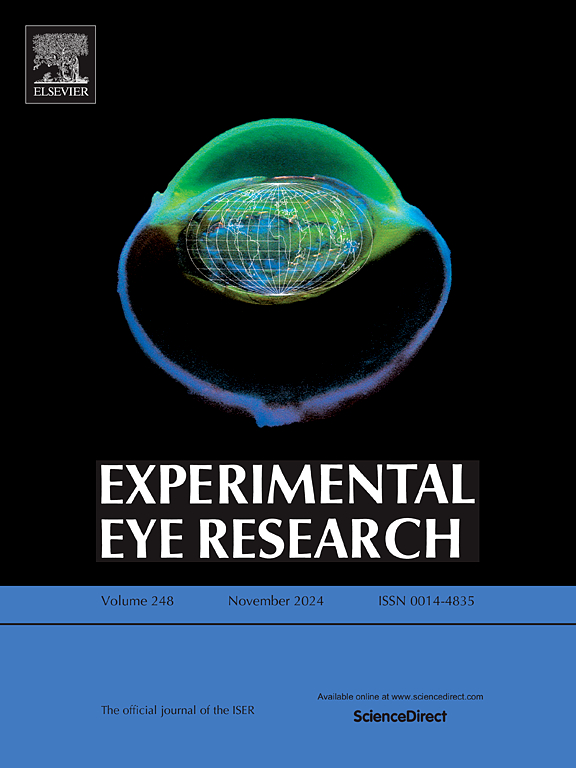Human corneal epithelial cells harvested from advanced surface ablation (ASA): An optimized in vitro culture protocol
IF 3
2区 医学
Q1 OPHTHALMOLOGY
引用次数: 0
Abstract
Purpose
Corneal epithelial cells obtained from advanced surface ablation (ASA) surgery provide a valuable resource for in vitro models of ocular surface diseases. The aim of this study is to enhance culture conditions and characterize the functionality of EpiASA cells in culture, focusing on their ability to keep the distinctive properties of corneal epithelial cells.
Methods
EpiASA samples from 51 patients were included in the study. Two different collection media were tested, and their effect on sample preservation and initial viability was evaluated. Then, cells were disaggregated and cultured using different strategies to increase cell viability, which was measured by AlamarBlue assay. Once the optimized conditions were established, cells were cultured and passaged, and structural and functional characterization of native tissue, primary cultures, and first-passage cultures was performed using atomic force microscopy (AFM), qPCR, and immunofluorescence stainings.
Results
The addition of trehalose to the basal collection medium increased EpiASA initial viability. Culture surface coating with type I collagen, along with the supplementation of culture medium with hydrocortisone, significantly increased cell viability. On the contrary, co-cultures with different ocular cell lines, or the use of human serum, did not provide a sustained benefit. Further low-concentration trehalose supplementation of EpiASA cultures enhanced monolayer formation and allowed subculturing. AFM and immunofluorescence confirmed that passage 1 EpiASA cells retained corneal epithelial characteristics, including well-organized microvilli and uniform expression of barrier and epithelial markers.
Conclusion
This research provides an optimized protocol (EpiKeraMAX) for using EpiASA samples for in vitro studies of human corneal cells.
从高级表面消融(ASA)中收获的人角膜上皮细胞:一种优化的体外培养方案。
目的:晚期表面消融(ASA)手术获得的角膜上皮细胞为眼表面疾病的体外模型提供了宝贵的资源。本研究的目的是改善培养条件和表征EpiASA细胞在培养中的功能,重点研究其保持角膜上皮细胞独特特性的能力。方法:51例患者的EpiASA样本纳入研究。测试了两种不同的收集介质,并评估了它们对样品保存和初始活力的影响。然后,将细胞分解并采用不同的培养策略提高细胞活力,用AlamarBlue法测定细胞活力。一旦建立了优化的条件,细胞进行培养和传代,并使用原子力显微镜(AFM)、qPCR和免疫荧光染色对天然组织、原代培养和第一代培养进行结构和功能表征。结果:在基础培养基中加入海藻糖可提高EpiASA的初始存活率。在培养液中添加I型胶原蛋白,并在培养液中添加氢化可的松,可显著提高细胞活力。相反,与不同的眼部细胞系共同培养,或使用人血清,并没有提供持续的好处。进一步在EpiASA培养基中添加低浓度海藻糖,可以促进单层的形成,并允许继代培养。AFM和免疫荧光证实,传代1的EpiASA细胞保留了角膜上皮的特征,包括组织良好的微绒毛和均匀表达的屏障和上皮标志物。结论:本研究为EpiASA样品用于人角膜细胞的体外研究提供了一种优化的方案(EpiKeraMAX)。
本文章由计算机程序翻译,如有差异,请以英文原文为准。
求助全文
约1分钟内获得全文
求助全文
来源期刊

Experimental eye research
医学-眼科学
CiteScore
6.80
自引率
5.90%
发文量
323
审稿时长
66 days
期刊介绍:
The primary goal of Experimental Eye Research is to publish original research papers on all aspects of experimental biology of the eye and ocular tissues that seek to define the mechanisms of normal function and/or disease. Studies of ocular tissues that encompass the disciplines of cell biology, developmental biology, genetics, molecular biology, physiology, biochemistry, biophysics, immunology or microbiology are most welcomed. Manuscripts that are purely clinical or in a surgical area of ophthalmology are not appropriate for submission to Experimental Eye Research and if received will be returned without review.
 求助内容:
求助内容: 应助结果提醒方式:
应助结果提醒方式:


